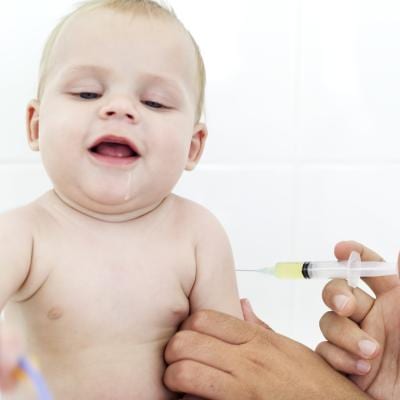Vaccines protect your baby from developing diseases, such as polio, measles and tetanus, that used to be commonplace in the United States. These diseases are much rarer today because of vaccines. Before children attend most schools in the United States, they have to have vaccines. The vaccination process begins between birth and 6 months of age.
First 6 Vaccines
Six vaccines are recommended for your baby by the Centers for Disease Control and Prevention (CDC). The first vaccine is for diphtheria, tetanus and pertussis, what doctors call the DTaP. Your baby gets this vaccine five times — at 2 months, 4 months, 6 months, 15 to 18 months and at 4 to 6 years. The second vaccine is hepatitis B. Your baby gets three doses of this; one at 2 months, one at 4 months and one at 6 to 18 months. The third vaccine is polio. Your baby gets four doses; one at 2 months, one at 4 months, one at 6 to 18 months and one at 4 to 6 years. The fourth vaccine is Haemophilus influenza type b, what doctors call Hib. Your baby gets three or four doses, depending on the type of Hib vaccine. Your baby gets one at 2 months, 4 months, maybe at 6 months, depending on the type of vaccine and one at 12 to 15 months. The fifth vaccine is the pneumococcal vaccine. Your baby gets four doses; one at 2 months, one at 4 months, one at 6 months and one at 12 to 15 months. The sixth vaccine is the rotavirus vaccine. Your baby gets two or three doses, depending on the type of vaccine. The first dose is at 2 months, the second dose is at 4 months and the 6-month dose is given, depending on the type of vaccine.
Why Get Vaccinated
This vaccination process protects your child from eight serious diseases that used to kill or injure children and adults routinely. For example, polio used to paralyze about 37,000 people each year during the 1950s before there was a vaccine for it. Diphtheria, a disease that led to breathing problems and heart failure used to kill 15,000 people a year before the vaccine. If the vaccines cease, the diseases will return.
Side Effects
Vaccines come with certain risks and side effects. Most children don’t get any side effects, or if they do, experience only mild reactions, such as a tenderness or redness at the site of the vaccination. Some kids get a slight fever, which usually lasts a day or two. The more serious reactions are severe allergic reactions to something in the vaccine. Fewer than one in a million shots cause a severe allergic reaction, according to the CDC. If an allergic reaction is going to happen, it usually occurs right away, and office staff should know how to deal with the situation.
Associations
Some conditions are associated with the vaccine, but there is no proof that the vaccine caused the condition. For example, the DTaP may cause fussiness, tiredness, poor appetite or vomiting. More moderate reactions to DTaP could be seizure, non-stop crying for three hours or more and a fever of more than 105 degrees F. Serious problems that have been associated with DTaP are long-term seizures, coma and permanent brain damage. These serious problems are rare, and there is no proof that the vaccine caused the problems.
When Not to Vaccinate
If your baby had any sort of reaction after the first or any subsequent DTaP vaccines, tell your doctor before getting any additional DTaP vaccines for your child. If your child is sick, don’t get the vaccinations on that day. Wait until she gets better. If your child has a weakened immune system, ongoing digestive problems, certain types of cancer or other diseases, you should discuss with your doctor whether you should have your child vaccinated.





